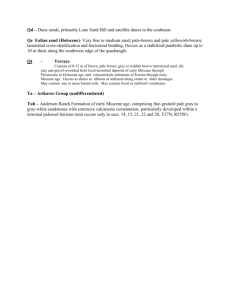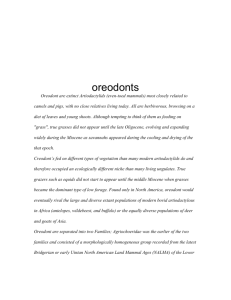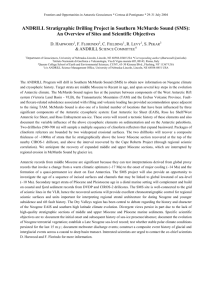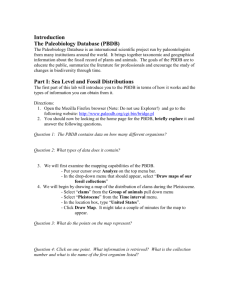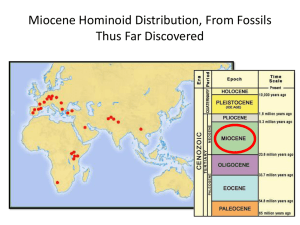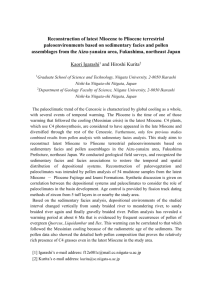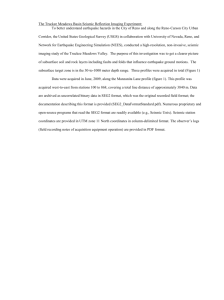Interpretations from the faunal list - Hal-SHS
advertisement
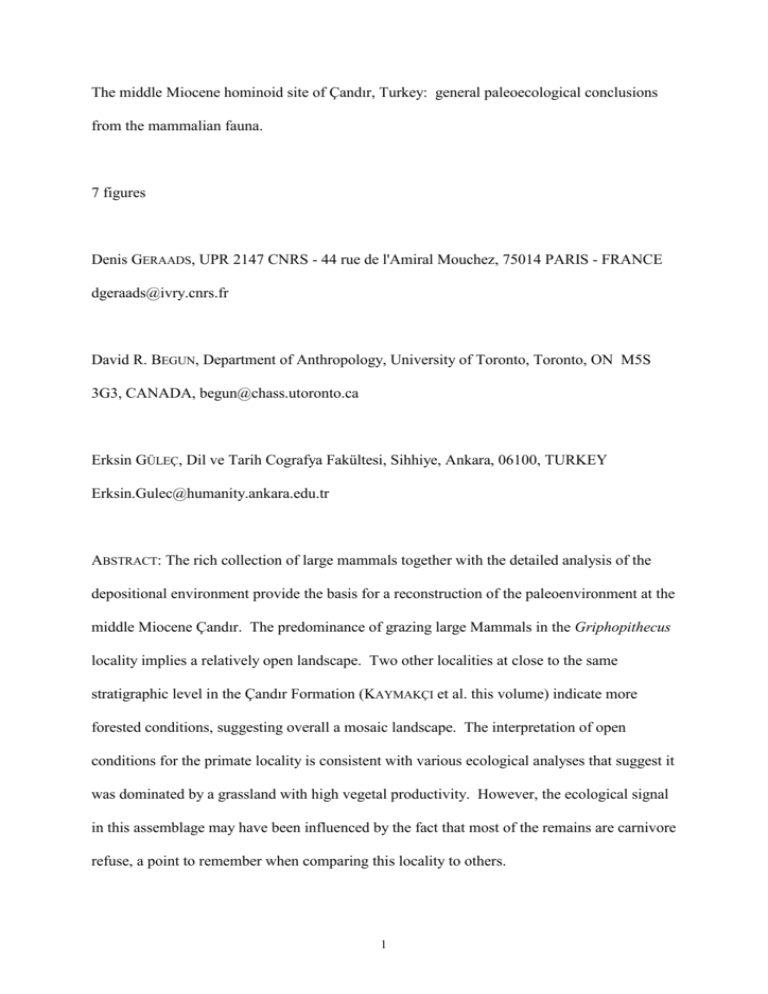
The middle Miocene hominoid site of Çandır, Turkey: general paleoecological conclusions from the mammalian fauna. 7 figures Denis GERAADS, UPR 2147 CNRS - 44 rue de l'Amiral Mouchez, 75014 PARIS - FRANCE dgeraads@ivry.cnrs.fr David R. BEGUN, Department of Anthropology, University of Toronto, Toronto, ON M5S 3G3, CANADA, begun@chass.utoronto.ca Erksin GÜLEÇ, Dil ve Tarih Cografya Fakültesi, Sihhiye, Ankara, 06100, TURKEY Erksin.Gulec@humanity.ankara.edu.tr ABSTRACT: The rich collection of large mammals together with the detailed analysis of the depositional environment provide the basis for a reconstruction of the paleoenvironment at the middle Miocene Çandır. The predominance of grazing large Mammals in the Griphopithecus locality implies a relatively open landscape. Two other localities at close to the same stratigraphic level in the Çandır Formation (KAYMAKÇI et al. this volume) indicate more forested conditions, suggesting overall a mosaic landscape. The interpretation of open conditions for the primate locality is consistent with various ecological analyses that suggest it was dominated by a grassland with high vegetal productivity. However, the ecological signal in this assemblage may have been influenced by the fact that most of the remains are carnivore refuse, a point to remember when comparing this locality to others. 1 Key-words: middle Miocene, Turkey, paleoecology, mammals Introduction The site of Çandır has long been acknowledged as one of the most important Miocene mammalian localities of the Old World, all the more as it has yielded a hominoid. It is listed in all general accounts on mammalian faunas of this period, and included in all biochronological charts. However, due to the lack of any detailed analysis on the whole fauna, interpretations have relied on preliminary faunal lists. Even the most recent faunal list (SEN et al. 1998), complied from the literature, is incomplete and erroneous in some instances. The present paper, based upon studies by various specialists of the entire collection of mammals from Çandır, provides an update of the conclusions that can be drawn from this sample. Çandır has yielded 20 species of large non-carnivorous mammals, and as many genera. Çandır also contains 9 carnivore taxa and 18 micromammal taxa. Its age is close to Paşalar and Inönü I, and probably more recent than the former, but its chronological placement relative to the latter is equivocal. Correlation with Western Europe is also difficult. The traditional inclusion of Çandır in zone MN6 is cannot be taken for granted because of potentially strong regional differences both between Europe and Turkey. The age of Çandır and its implications are discussed in more detail in the last chapter. Interpretations from the faunal list The most recently updated lists of large Mammals from Paşalar, Çandır, and Inönü, together with the minimum numbers of individuals of non-carnivorous Mammals, in brackets, are listed in table 1. The micromammals from Çandır are listed in DE BRUIJN et al. (this volume). 2 Table 1 about here Origin of the bone accumulation At the Griphopithecus locality (Loc. 3), the occurrence of coprolites, of gnawing marks on some bones, the strong breakage of most bones suggest carnivore accumulation. This pattern is even visible on the primate mandible, which may have lost its rami to a carnivore after the temporalis muscle. The base of the right corpus is also damaged with a large spiral shaped piece of bone missing (GÜLEÇ & BEGUN this volume). Analysis of the age structure of the population also supports the interpretation of a carnivore accumulation. We have measured the height of the third molars of Hypsodontus, an ungulate that is relatively abundant, and in which this height can be measured with reasonable accuracy. We have completed it by adding the heights of DP4. It seems that M3 just starts wearing when DP4 is shed (and not earlier, as GENTRY 1990, fig.7, thought). We have supposed that its potential longevity is 192 months, and shedding DP4 / early wearing M3 is at 24 months (average of GENTRY'S ages). We have computed the mortality profile from KLEIN & CRUZ-URIBE (1984), as GENTRY did. However, it seems to us that these ages and method of calculation shorten the period of milk-teeth wearing, and lengthen the period of late wear of M3. Since we may consider that the last milk-premolar is shed when M3 starts wearing, we have added the heights of these two teeth (when unworn, 15 mm, and 27 mm, respectively), and made an histogram (Fig.1) directly from the total height (e.g. a DP4 7 mm high will give a value of 34). There is a clear shortage of specimens in middle wear of M3, but excess of young and very old specimens. This is clearly an "attritional profile", which could fit natural mortality, but the other species do not display the same profile, as would be expected in this case. For example, almost all Tethytragus and all Micromeryx are adults, there being almost no milk teeth of 3 these genera. The absence of milk-teeth is too striking to be explained just by a taphonomic factor or a collecting bias (milk teeth being less robust or less easily seen). In addition, 3 out of 5 Giraffokeryx and the only Palaeomeryx lower tooth series contain milk teeth. Figure 1 about here All this fits a carnivore accumulation, with only the smaller species, Tethytragus and Micromeryx being caught as adults. This implies that the fauna from Loc. 3 is a biased sample of the fauna living at that time, and this should not be forgotten when interpreting its ecological meaning, but we do not believe that the conclusions that we can draw from the fauna could be seriously affected. Paleoecology Functional interpretations (Ecomorphology) Figure 2 displays the proportions of the various groups of ungulates at Çandır Loc. 3. The bulk of the fauna consists of ruminants. Frugivorous, omnivorous or folivorous mammals are extremely rare, being represented by a few suoids, chalicotheres, proboscideans and one primate, Griphopithecus alpani. GÜLEÇ & BEGUN (this volume) and SMITH (1999) conclude from the analysis of the Çandır mandible that Griphopithecus was a frugivorous, hard object feeder, and KING et al. (1999) reach the same conclusion based on their analysis of the same taxon at Paşalar. This is more consistent with a forest or wooded habitat. Among the rhinos, Beliajevina, with its high-crowned and complex occlusal morphology, was certainly a grazer, although young individuals (FORTELIUS 1990), as well as other species might have been mixed feeders. Brachypotheres have often been compared to hippos, but the long slender humerus is more reminiscent of an elephant, and they could have inhabited open 4 country as well. Chalicotheres have very brachyodont teeth, and certainly consumed soft food. Anchitheriines were likely mixed feeders, and are commonly thought to have been forest dwellers (GÜLEÇ & GERAADS, this volume). The strongly developed lophodonty of the suids Listriodon, and to a lesser extent Bunolistriodon are indications of a grazing, folivorous diet, along with their broad, low crowned incisors (VAN DER MADE, this volume). These and other indications (absence of morphology associated with rooting and evidence of limbs adapted to cursorality (VAN DER MADE, this volume) are consistent with a preference for open habitat. In contrast, the palaeochoerid Schizochoerus, with somewhat less developed lophodonty, is interpreted as a “browsing folivore” (VAN DER MADE, this volume) and may have had a preference for somewhat more wooded conditions. Among the ruminants, we may surmise that Giraffokeryx and Micromeryx were mixed feeders, and the only definite browsers were Palaeomeryx and Heteroprox, with their very brachyodont teeth. Turcocerus and Hypsodontus, with their short premolar rows and very hypsodont teeth (especially noticeable for middle Miocene animals) were highly adapted for grazing, and even Tethytragus, by far the most common large mammal at Çandır, has relatively hypsodont teeth for its geological age, although isotope analysis (QUADE et al. 1995) suggests that it was a mixed feeder. Thus, the conclusions that can be drawn from the ecological interpretation of large Mammals are rather straightforward: they point towards an open environment, even though a few animals document some other biotopes. It should be noted, however, that this result arises mainly from the study of Loc.3, and that the predominance of grazers is less striking in Loc.1. The lack of precise provenance data in collections from Loc. 1, made mainly by earlier researchers, prevent the computation of precise relative proportions, but there is little doubt that there were indeed differences, as shown in table 2. 5 Figure 2 about here Table 2 about here The differences between the 2 large mammal localities of Çandır, which are about as great as those between Çandır as a whole and Paşalar, demonstrate that Loc.1 sampled a much less open environment than Loc. 3. Both localities are certainly nearly contemporaneous and differ mainly by their sedimentary environment. Loc.1 was closer to the lake margin, where the greater number of browsers may attest the presence of a riparian vegetation. Another possible bias arises from the nature of bone accumulation, which was largely carnivore refuse at Loc.3, but of unknown origin at Loc.1. As noted in DE BRUIJN, et al. (this volume), the micromammals were collected from a third locality at Çandır, separated from the main locality (Loc. 3) by sixty meters laterally and two meters vertically. The geology of the Çandır area (KAYMAKÇI, et al. this volume) indicates that the localities are nearly contemporaneous, but again, the micromammal locality is in a more lacustrine context that suggests some paleoenvironmental differences from the primate locality (Loc. 3). The micromammal fauna is consistent with a relatively more forested setting (DE BRUIJN et al. this volume ; ÜNAY personal communication). While there are some taxa usually associated with more open settings (lagomorphs, ground squirrels, and spalacids (blind, borrowing rodents), a number of Çandır micromammals suggest forested or humid conditions, while others give ambiguous ecological signals. Hypsodonty in the lagomorphs Prolagus and Alloptox suggests grazing and a preference for open country, as does the fossil ground squirrel Spermophilinus, the dormouse Myomimus (which is abundant in the sample ((DE BRUIJN, personal communication)) and the presumably blind, burrowing Pliospalax. However, DE BRUIJN (1999) only tentatively groups 6 Tamias with the ground squirrels, recognizing an ecological preference for this taxon intermediate between ground and tree squirrels. The flying squirrels Forsythia and Albanensia more clearly reflect forested conditions (DE BRUIJN 1999). The dormouse Muscardinus is associated today with wooded habitats and the dentally similar Miocene species probably had similar dietary preferences (DAAMS 1999). The same holds for Glirulus, the extant Japanese dormouse, which is arboreal (DAAMS 1999). The extinct eomyids are thought to be indicators of humid or closed conditions (VAN DER MEULEN & DAAMS 1992, DAAMS & VAN DER MEULEN 1984). The Çandır eomyids Eomyops and Keramidomys have relatively bunodont molars that are structurally similar to Eomys, the only eomyid from which postcrania are known (ENGESSER 1999). A remarkably well preserved specimen of Eomys quercyi from Enspel shows clearly that it was a glider (STORCH, et al. 1996), another clear indication of the presence of trees. The extinct hamster-like muroid rodents Cricetodon, Megacricetodon, and Democricetodon are more ambiguous. Cricetodon has been interpreted as suggestive of forested conditions similar to the preferred ecology of the modern hamster Cricetus (RUMMEL 1999), while DE BRUIJN & ÜNAY (1996) suggest that Anatolian cricetodontini may have preferred drier settings. Megacricetodon may have been more opportunistic (DAAMS et al. 1988, KÄLIN 1999). FAHLBUSCH (1996) cautions that geographically widespread and long-lived cricetid genera like Megacricetodon and Democricetodon are uncertain paleoecological indicators, and DE BRUIJN (personal communication) concludes that Megacricetodon is commonly associated with open country while Democricetodon could have been a forest form. In conclusion, the ecomorphology of mammals from the three Çandır localities suggest a mosaic landscape, ranging from more open country at the primate locality to more forested conditions nearer to the lake margin. The presence of small numbers of typically forest or woodland dwellers at the primate locality and the micromammal locality suggests the presence of nearby more wooded areas. The 7 carnivore or carnivores responsible for the accumulation of bones at Loc. 3, while having a preference for smaller, open country taxa, occasionally sampled from more wooded areas. The environment of a fossil locality can also be deduced from the structure of the animal community, and large non-carnivorous mammals are now commonly used for this purpose. There are several ways to extract the information that they provide, mainly according to the way this community is classified. We used faunal diversity, body weight and taxonomy. Faunal Diversity The easiest way to determine faunal richness is to count the number of species, S (table 3). There are 20 species of non-carnivorous large mammals at Çandır, 22 at Paşalar and 18 at Inönü. However, this number is influenced by the number of individuals (i.e. of specimens that were collected), N (table 3). A better estimate of richness is given by indices such as MARGALEF'S S-1/lnN, or MENHINICK'S, S/ N (table 3). Other indexes take into account the relative abundance of species; thus, they depend both on the number of species and on the evenness of the distribution of specimens across species. Of special interest are eH' (H' being SHANNON-WEAVER index, [ni/N.ln(ni/N)]) which is a measure of the number of abundant species, and 1/ ( being SIMPSON'S index , [ni(ni-1)/N(N-1)]), which is a measure of very abundant species (table 3). Of course, caution is urged in interpreting these indexes, because they also depend on taphonomy, collecting procedures, and chance, but on the whole, Çandır is slightly more diverse than Paşalar, both being comparable to Vallesian and early Turolian sites of Greece and Turkey, but less diverse than later Turolian sites, like Pikermi, Dityko, or Kemiklitepe A-B (data from ANDREWS 1990, DE BONIS et al. 1992, 1994) (table 3). Table 3 about here 8 Body weight Cenograms illustrate the distribution pattern of body weight across a faunal community. All non-carnivorous species are plotted on the X-axis, against the natural logarithm of their body weight on the Y-axis. The resulting series of points can be empirically fitted to a straight or broken line, or there may be a gap between larger and smaller species. Ecological interpretation can be drawn from the shape of the line(s) and from its (their) slope(s). A steep slope for larger mammals, for instance, would mean an arid open climate, provided, of course, that the fauna is well sampled, since the slope depends only upon the number of species. The slope for Çandır is very weak (Fig.3), meaning a large number of large species: this would be characteristic of a humid environment, with high vegetal productivity. It compares favorably with the cenogram of Paşalar (Fig.4) that we have redrawn from Andrews' data, because the cenogram that he provided (ANDREWS 1990: Fig.2) is obviously incorrect (even if one assumes that squares and dots have been inverted, the number of heavy taxa is much too small). Figures 3 and 4 about here Taxonomy A factor analysis was performed on a sample of 49 Recent localities, this time using as variables the number of species in each taxonomic group (proboscideans, suids, tragulids, giraffids, bovids, monkeys, apes, rhinos, equids, tubulidentates, hyracoids, hippos), and plotting on the resulting graph as illustrative (non-active) 82 fossil localities (Fig.5). The clouds corresponding to each major period (lower-middle Miocene, upper Miocene, PlioPleistocene, Recent) are well separated, and the position of the localities should be interpreted with respect to other localities of the same period. For instance, upper Miocene localities look (and probably were) more open (to the left of the graph) than those of the lower-middle 9 Miocene or Plio-Pleistocene. Inönü plots close to upper Miocene sites. This suggest that it is more recent and / or more open than other middle Miocene sites. Çandır is not far, and more to the left than almost all other middle Miocene sites. We believe that this confirms the relative openness of its environment, and its distinction from the more wooded one of Paşalar. Other analyses yielded basically the same results. When the analysis is run on fossil localities as active, factors 1-2 reflects geography rather well, but chronology is also strongly influential along factor 1 (Fig.6). Çandır plots again between Paşalar and the upper Miocene (plus Inönü). Analysis based upon middle and upper Miocene localities mainly sort the localities according to chronology (Fig.7). Chronology is mainly responsible for Factor 1, with all middle Miocene localities well separated (to the left of the graph) from upper Miocene ones (to the right), except Spanish Upper Miocene ones, which still plot among the middle Miocene. This probably means that faunal evolution during the middle and late Miocene was more or less uniform from Central Europe to Turkey. Figures 5-7 about here Summary and Conclusion The rich fauna from Çandır permit some fairly reliable conclusions about the paleoecology of this part of Turkey in the middle Miocene. The functional anatomy of the mammals suggest a diversity of biotopes, indicating a mosaic environment with more wooded conditions close to the lake margin and more open conditions upstream. Relatively strong differences in ecological signals between Localities 1 and 3 may be explained in part by habitat diversity, and also by differences in site formation processes, the latter collection having been accumulated by carnivores. Faunal diversity indices suggest slightly drier conditions at Çandır than at Paşalar, but not so open as at Inönü I or upper Miocene localities 10 in Greece and Turkey. This is also consistent with a complex and varied landscape with a relatively dominant open country component. The cenograms tend to confirm the broad similarity to Paşalar, but do not exclude somewhat more open conditions. Finally, the factor analyses also suggest drier conditions than at Paşalar, but less open than at later Miocene localities. More work is needed, but it is clear from this preliminary analysis that Çandır and Paşalar were similar places, probably a relatively dry, seasonal subtropical woodland habitat (ANDREWS 1990), but that Çandır had a somewhat more dominant open country biotope. Acknowledgments D.G and D.R.B. are grateful to Erksin GÜLEÇ for the opportunity to work on the fossils in her care. All three authors are grateful to the authors of this volume for the efforts they have made to help us put together a synthesis of Çandır paleoecology, and to Hans DE BRUIJN for reading a draft of this manuscript and contributing helpful insights. This work has been supported by the Programme "Paléoenvironnements, Evolution des Hominidés" of the CNRS (D.G.), NSERC, and the Alexander VON HUMBOLDT Stiftung (D.R.B.). References ANDREWS, P. (1990): Palaeoecology of the Miocene fauna from Paşalar, Turkey.- J. Hum. Evol., 19: 569-582; London. ANDREWS, P. & BERNOR, R.L., (1999): Vicariance biogeography and paleoecology of Eurasian Miocene Hominoid Primates.- In: AGUSTI, J. ; ROOK, L. & ANDREWS, P. (eds.): The Evolution of Neogene Terrestrial Ecosystems in Europe.- 454-487; Cambridge (Cambridge University Press). BERNOR, R.L. & TOBIEN, H. (1990): The mammalian geochronology and biogeography of Paşalar (middle Miocene, Turkey).- J. Hum. Evol., 19; 551-568; London. 11 BONIS, L. DE; BOUVRAIN, G.; GERAADS, D.; & KOUFOS, G. (1992): Multivariate study of late Cenozoic mammalian faunal compositions and paleoecology.- Paleont. i Evolucio, 2425: 93-101; Sabadell. BONIS, L. DE; BOUVRAIN, G.; GERAADS, D. & SEN, S. (1994): Les gisements de Mammifères du Miocène supérieur de Kemiklitepe, Turquie. 12 - Biostratigraphie, paléoécologie et relations biogéographiques.- Bull. Mus. Nat’l. Hist. Nat.,- 16; 225-240; Paris. BRUIJN H. DE (1999): Superfamily Sciuroidea. – In: RÖSSNER, G.E. & HEISSIG, K. (eds.): The Miocene Land Mammals of Europe. - 271-280; München (Pfeil) BRUIJN H. DE & ÜNAY E. (1996): On the evolutionary history of the Cricetodontini from Europe and Asia Minor and its bearing on the reconstruction of migrations and the continental biotope during the Neogene. – In: BERNOR, R.L.; FAHLBUSCH, V. & MITTMANN, H.-W. (eds.): The Evolution of Western Eurasian Neogene Mammal Faunas. – 227-234; New York (Columbia University Press). DAAMS R (1999): Family Gliridae.- In: RÖSSNER, G.E. & HEISSIG, K. (eds.): The Miocene Land Mammals of Europe. – 301-318; München ( Pfeil) DAAMS, R.; FREUDENTHAL, M; & VAN DER MEULEN, A.J. (1988): Ecostratigraphy of micromammal faunas from the Neogene of Spain. – In: Freudenthal. M. (ed.): Biostratigraphy and paleoecology of the Neogene micromammalian faunas from the Calatayud-Teruel Basin (Spain). Scripta Geologica Special issue, 1: 287-302. Leiden: DAAMS, R.; VAN DER MEULEN, A.J.; ALVAREZ SIERRA, M..A.; PELAEZ-CAMPOMANES, P. & KRIJGSMAN, W. (1999): Aragonian stratigraphy reconsidered and a re-evaluation of the middle Miocene mammal biochronology in Europe. - Earth Planet. Sci. Lett., 165: 287-294; Amsterdam. DAAMS, R. & VAN DER MEULEN, A.J. (1984): Paleoenvironmental and paleoclimatic 12 interpretation of micromammal faunal successions in the Upper Oligocene and Miocene of north central Spain. - Paléobiol. Cont., 14: 241-257; Montpellier. DURANTHON, F.; MOYÁ-SOLÁ, S.; ASTIBIA, H. & KÖHLER, M. (1995): Ampelomeryx ginsburgi nov.gen., nov.sp. (Artiodactyla, Cervoidea) et la famille des Palaeomerycidae. - C. R. Acad. Sci., sér.IIa, 321: 339-346, Paris. ENGESSER, B. (1999): Family Eomyidae. In RÖSSNER, G.E. & HEISSIG, K. (eds.): The Miocene Land Mammals of Europe. - 319-335; München (Pfeil). ENGESSER, B. (1980): Insectivora und Chiroptera (Mammalia) aus dem Neogen der Türkei. Schw. Paläontol. Abh., 102: 49-149, Basel. FAHLBUSCH, V. (1996): Middle and late Miocene common cricetids with prismatic teeth. -In BERNOR, R.L.; FAHLBUSCH, V. & MITTMANN, H.-W. (eds.): The Evolution of Western Eurasian Neogene Mammal Faunas. -216-219; New York (Columbia University Press). FORTELIUS, M. (1990): Rhinocerotidae from Paşalar, middle Miocene of Anatolia. - Turkey: J. Hum. Evol., 19: 489-508, London. GABUNIA, L.K. (1973): Fossil vertebrate fauna of Byelomyechyetskaia : Metsnierba, 136 p. Tbilissi [in Russian]. GAZIRY, A. (1976): Jungtertiäre Mastodonten aus Anatolien (Türkei). - Geol. Jahrb., B, 22: 3143. GENTRY, A. W. (1990): Ruminants artiodactyls of Paşalar, Turkey. - J. Hum. Evol., 19: 529550, London. GENTRY, A.W. (1994): The Miocene differentiation of old world Pecora (Mammalia). - Hist. Biol., 7: 115-158. GERAADS, D.; GÜLEÇ, E. & SARAÇ, G. (1995): Middle Miocene Ruminants from Inönü, 13 Central Turkey. - Neues Jahrb. Geol. Paläontol. Monat., 8: 462-474. GÜRBÜZ, M. (1981): Inönü (KB Ankara) Orta Miyosenindeki Hemicyon sansaniensis (Ursidae) türünün tanimlanmasi ve stratigrafik yayilimi. - Bull. Geol. Soc. Turkey, 24: 85-90, Ankara. KÄLIN, D. (1999): Tribe Cricetini. - In RÖSSNER, G.E. & HEISSIG, K. (eds.): The Miocene Land Mammals of Europe. – 373-387; München ( Pfeil). KAPPELMAN, J.; SEN, S; FORTELIUS, M.; DUNCAN, A.; ALPAGUT, B.; CRABAUGH, J.; GENTRY, A.; LUNKKA, J.P.; MCDOWELL, F.; SOLOUNIAS, N.; VIRANTA, S. & WERDELIN, L. (1996): Chronology and biostratigraphy of the Miocene Sinap Formation of Central Turkey. In: BERNOR, R.L.; FAHLBUSCH, V. & MITTMANN, H.-W. (eds.): The Evolution of Western Eurasian Neogene Mammal Faunas. - 78-95; New York (Columbia University Press). KING, T.; AIELLO, L.C.; & ANDREWS, P. (1999): Dental microwear of Griphopithecus alpani. – J. Hum. Evol., 36: 3-31, London. KLEIN, R. & CRUZ-URIBE, K. (1984): The Analysis of Animal Bones from Archeological Sites. - 1-266; Chicago (University of Chicago Press). KRIJGSMAN, W.; GARCÉS, M.; LANGEREIS, C.G.; DAAMS, R.; DAM, A.J. VAN; MEULEN, A.J. VAN DER; AGUSTÍ, J. & CABRERA, L. (1996): A new chronology for the middle to late Miocene continental record in Spain. - Earth Planet. Sci. Lett., 142: 367-380, Amsterdam. LUNKKA, J. P.; FORTELIUS, M.; KAPPELMAN, J. & SEN, S. (1999): Chronology and mammal faunas of the Miocene Sinap Formation.. - In: AGUSTI, J., ROOK, L., AND ANDREWS, P. (eds.): The Evolution of Neogene Terrestrial Ecosystems in Europe. - 238-264; Cambridge (Cambridge University Press). 14 VAN DER MEULEN, A.J. & DAAMS, R. (1992): Evolution of Lower-Middle Miocene rodent faunas in relation to long term paleoenvironmental changes. - Palaeogeogr. Palaeoclimatol. Palaeoecol., 93: 227-253, Amsterdam. QUADE, J.; CERLING, T.; ANDREWS, P. & ALPAGUT, B. (1995): Paleodietary reconstruction of Miocene faunas from Paşalar, Turkey using stable carbon and oxygen isotopes of fossil tooth enamel. - J. Hum. Evol., 28: 373-384; London. RUMMEL, M. (1999): Tribe Cricetodontini. - In RÖSSNER, G.E. & HEISSIG, K. (eds.): The Miocene Land Mammals of Europe. – 359-364; München (Pfeil). SANDERS, W.J. (1998): New proboscidean fossils from the Sinap Formation, Central Turkey. - J. Vert. Palaeontol., 18 (supp. to N°3): 75A. SCHMIDT-KITTLER, N. (1976): Raubtiere aus dem Jungtertiär Kleinasiens. Paleontographica, 155: 1-131. SEN, S. (1990): Middle Miocene lagomorphs from Paşalar, Turkey. - J. Hum. Evol., 19: 455461, London. SEN, S.; SEYITOGLU, G.; KARADENIZLI, L.; KAZANCI, N.; VAROL, B. & ARAZ, H. (1998): Mammalian biochronology of Neogene deposits and its correlation with the lithostratigraphy in the Çankiri-Çorum basin, central Anatolia, Turkey. - Ecol. Geol.Helv., 91: 307-320. SMITH, E.J. (1999) A Functional Analysis of Molar Morphometrics in Living and Fossil Hominoids Using 2-D Digitized Images. Dissertation, University of Toronto. STORCH, G.; ENGESSER, B., & WUTTKE, M. (1996): Oldest fossil record of gliding in rodents. -Nature 379; 439-441, London. TOBIEN, H. (1990): Proboscidea : a preliminary note. - J. Hum. Evol., 19; 465-469. ÜNAY, E. (1990): Turkomys pasalarensis TOBIEN, its range of variation in the type locality at Paşalar, Turkey. - J. Hum. Evol., 19; 437-443. 15 Table 1: Large mammals from Çandır, Paşalar, and Inönü. PAŞALAR (378)* ÇANDIR(94)** Griphopithecus darwini (49) Griphopithecus alpani (1) Amphicyon cf. A. major Amphicyon major Hemicyon sansaniensis Hemicyon sansaniensis Plithocyon sp. Ursavus cf. U. primaevus Ursavus aff. U. intermedius Plesiogulo sp. Proputorius sp. cf. Proputorius Trochictis sp. cf Trochictis depereti Lutrinae Ischirictis (Hoplictis) anatolicus Protictitherium intermedium Protictitherium aff. P. gaillardi Protictitherium intermedium Protictitherium aff. P. gaillardi Protictitherium sp. Protictitherium. sp. Percrocuta miocenica Percrocuta miocenica Percrocuta sp. Percrocuta sp. Pseudailurus cf. P. quadridentatus P. quadridentatus 16 INÖNÜ *** Hemicyon sansaniensis Pseudailurus lorteti Orycteropus sp. (1) Orycteropus seni (1) Deinotherium aff. D. levius (2) Deinotherium sp. (1) Orycteropus sp. Gomphotherium pasalarense (7) Gomphotherium angustidens Choerolophodon sp cf Protanancus sp Pliohyracidae (1) Anchitherium aurelianense (21) Anchitherium aurelianense (5) Anchitherium aurelianense Anchitherium sp. Beliajevina tekkayai (13) Beliajevina cf B. grimmi (3) Beliajevina cf. grimmi Aceratherium aff. A. tetradactylum (2)A. cf. A. tetradactylum (3) Hoploaceratherium sp. Brachypotherium brachypus (4) B. cf B. brachypus (2) Brachypotherium sp. cf. Lartetotherium ? sp. (1) Chalicotherium grande (3) Chalicotherium cf. C. grande (1) Schizochoerus anatoliensis (6) Taucanamo inonuensis (3) Taucanamo inonuensis Kubanochoerus mancharensis Bunolistriodon meidamon (31?) Listriodon splendens (32?) Bunolistriodon meidamon (3) Listriodon splendens (3) Bunolistriodon latidens Listriodon splendens Conohyus simorrensis (6) Dorcatherium sp. (6) Palaeomeryx sp. (2) Palaeomeryx sp. (2) ? Stephanocemas sp. (7) Heteroprox anatolicus (3) ? Micromeryx sp. (6) Micromeryx sp. (7) ? Hispanomeryx sp. (1) 17 Micromeryx sp. Giraffokeryx aff. G. punjabiensis (28) Tethytragus koehlerae (112) G. anatoliensis (7) G. cf. G. anatoliensis Tethytragus koehlerae (25) Tethytragus koehlerae Hypsodontus pronaticornis (41) Hypsodontus pronaticornis (16) Turcocerus gracilis (3) H. pronaticornis major Turcocerus gracilis cf. Protoryx sp. Notes to table 1: * BERNOR & TOBIEN (1990); VAN DER MADE, this volume ** this volume. *** GÜRBÜZ (1981); GERAADS et al. (1995); KAPPELMAN et al. (1996); SANDERS (1998); LUNKKA et al. (1999); GERAADS & ASLAN, this volume; VAN DER MADE, this volume 18 Table 2: Relative abundance comparisons between 2 localities at Çandır. See text for discussion. Loc.1 Loc.3 Micromeryx common common Palaeomeryx rare very rare Heteroprox uncommon very rare Giraffokeryx common common Turcocerus absent rare Hypsodontus absent ? common Tethytragus very common very common 19 Table 3: Various faunal diversity indices for Çandır and other middle and late Miocene localities. See text for discussion N (MNI) S S/N (S-1)/lnN eH' 1/ Çandır 94 20 2.06 4.18 12 8.62 Paşalar 378 22 1.13 3.54 10.48 7.17 Ravin de la Pluie 130 19 1.67 3.70 11.25 5.20 Ravin des Zouaves 120 22 2.00 4.38 11.02 6.85 Kemiklitepe D 52 14 1.94 3.29 11.47 12.20 Kemiklitepe A-B 54 23 3.13 5.51 19.30 14.53 Prochoma 60 13 1.68 2.93 6.89 5.26 Pikermi 216 32 2.18 5.76 18.73 12.5 Dityko 147 23 1.90 4.41 13.46 11.36 20 Figure legends Fig. 1 Histogram of the heights of Hypsodontus lower teeth. We have pooled the heights of m3 and those of dp4, by adding 27 mm to the latter (height of unworn m3), assuming that m3 starts wearing when dp4 is shed. Fig.2. Proportions of the various groups of large Mammals at Çandır. A. Sample sizes. B. Minimum numbers of individuals Fig.3. Cenogram of Çandır. Fig.4. Cenogram of Paşalar. Fig.5. Factor analysis on the number of species in each taxonomic group, using Recent localities (blue dots) as active, fossil sites as illustrative. Large red squares are the environment of Recent localities. Note the clear distinction between lower-middle Miocene localities (in blue) and upper Miocene ones (in green), except Çandır and Inönü, which plot among upper Miocene sites. Only the Turkish sites and Samos are labeled. Abbreviations are self-evident except for: SAV.OP.WDLD = Savannah, open woodland; PRI> = Hominoidea; PRI< = other Primates; HIPO = Hippos and Anthracotheres Fig.6. Factor analysis on the number of species in each taxonomic group, using all fossil localities (blue dots, except Turkish sites and Samos in green) as active. Abbreviations as for Fig.5, plus: DINO = Deinotherium; PROB = other Proboscidea; CHAL = Chalicotheriidae. 21 Fig.7. Factor analysis on the number of species in each taxonomic group, using all middle and upper Miocene localities as active. Note the good sorting of localities along axis 1 according to chronology. 22
